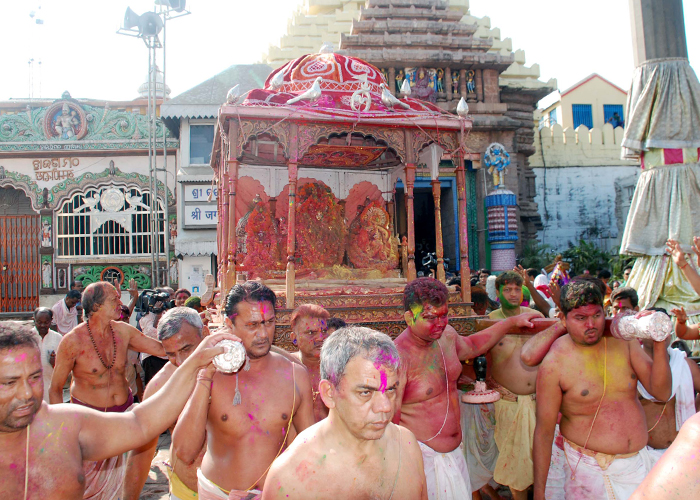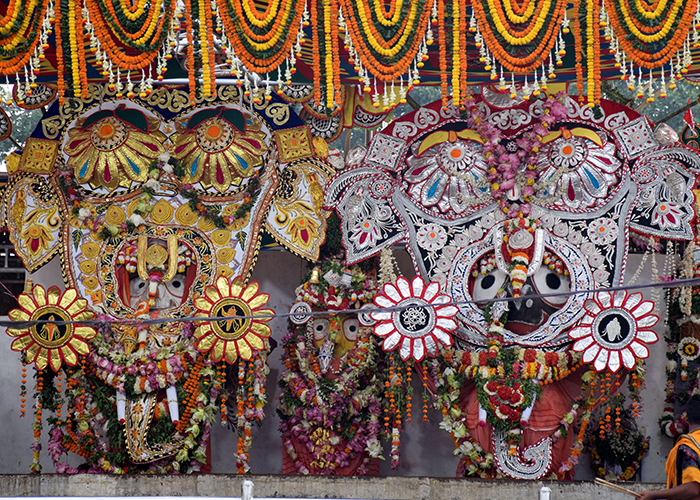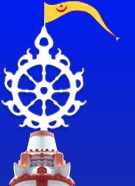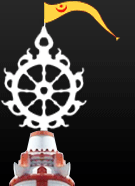
Jagannatha is regarded as the supreme god and the sovereign monarch of the Odishan empire. The entire ritual pattern of Jagannatha has been conceived keeping such twin aspects in view. The ritual system of the temple is very elaborate and complex involving a multitude of functionaries above one thousand spread over one hundred categories. The rituals of Jagannatha can broadly be divided into three parts – the daily, the occasional and the festive. In Jagannatha temple these rituals assume the term ‘niti’.
The fixed nitis that are observed daily as of routine. The periodical nitis are observed on occurrence of some specific occasions like, Ekadasi, Sankranti, Amabasya, on eclipses and Nakhatras etc. Lastly there are various festivals observed during the year some outside the temple like the Snana Yatra, the Ratha Yatra, the Chandana Yatra etc. and some inside the temple like Jhulan Yatra or swinging ceremony etc. Each sevaka or the temple functionary has his specified duty to perform in these nitis having terms and times specified. Unless, a particular niti is performed, the next one cannot take place and consequently punctuality sometimes fluctuates to ensure attendance of various categories of sevakas required for a particular Niti.


The word ‘Niti’ in Sanskrit means a principle, a rule or policy. But this word is used in the Puri temple in a more general sense, signifying a particular religious rite performed in the temple.
The Nitis or rituals of the temple may be classified under three heads – (a) the daily Nitis, which are fixed and are observed every day as of routine course; (b) the special Nitis according to the specialty of certain days, months etc. or some mishaps in the temple, (c) the various festivals observed during the year.
The various Nitis, that are observed daily in the temple commence on about 5 A.M. and continue till midnight. They include in seriatim the Mangala Alati immediately after the doors of the temple are opened and an inspection made, Mailama (taking off the clothes and flowers of the previous night), Tadapalagi (putting on towels), Abakasa (cleaning of teeth and bathing) and Vesa (dressing). Then a public darsana called Sahana Mela is held, when the people are allowed to proceed near the Ratnavedi (jeweled throne), have a closer view of the deities and circumambulate. After the Sahana Mela, the deities again change their dress. In the meantime. Rosa Homa or an oblation to the fire is performed in the kitchen and the fire is used in all the hearths for cooking the food for the deities. Then follow the Surya Puja and the Dvarapala Puja, or the worship of the sun-god and the guardian deities, after which the Gopala Vallabha Bhoga is offered.

Next comes Sakala Dhupa, followed by Bhoga Mandapa Bhoga and the Madhyahna Dhupa, as mentioned earlier. The deities change dress at each meal time and after each meal betel nuts are offered. After the meals the deities enjoy a siesta, called Pahuda of the day-time. In the evening an Arati is performed to mark the beginning of the nocturnal functions. The next Niti is Sandhya Dhupa. Devotees are again offered an opportunity of Sahana Mela in the evening hours. Then the deities change their dress, wear special silken clothes, fresh flowers and ornaments, besmear sandal-wood paste and enjoy music and dance performed by specified Sevakas. This dress goes by the name Badasingara Vesa and the light food offered on this occasion is known as Badasingara Bhoga. Green coconuts are then offered and detailed arrangements are made for the sacred slumber of the deities (Pahuda), after which the light is put off and the door is closed and sealed. But many more Nitis are performed on special occasions, For example, the Ekadasi Nitis are observed when a sebak of the temple services scales to the top of the temple (about 200 feet high) after night fall and burns a lamp there amidst the loud cheers of thousands of spectators. On-every Thursday, goddess Laksml is washed, dressed and decorated carefully for a union with Vishnu in the form of Jagannatha. On new-moon days the moving idols of Jagannatha visit the sea-god Varuna, said to be the father of Laksmi.





